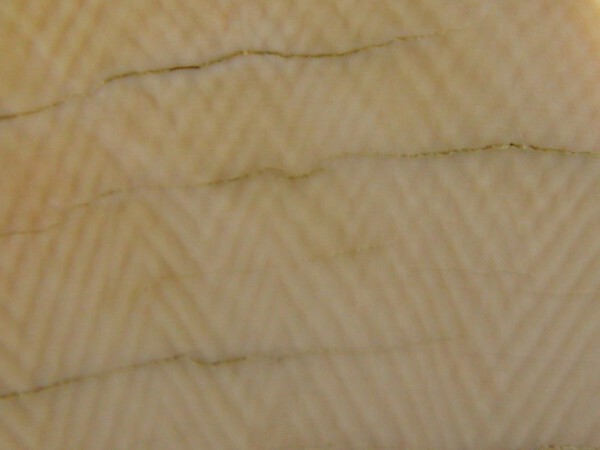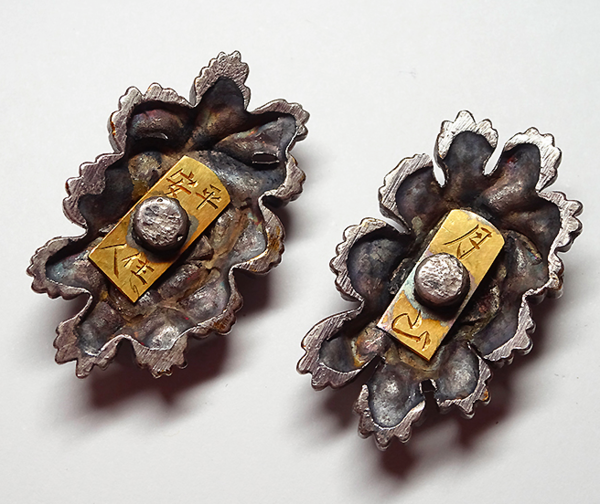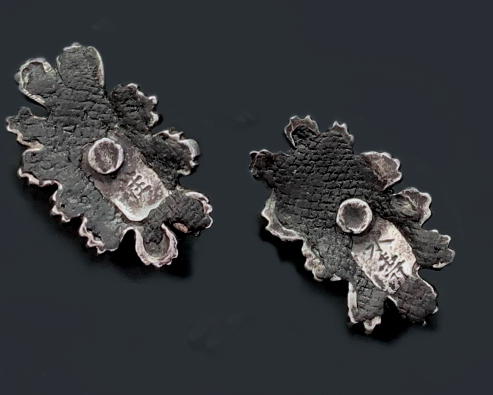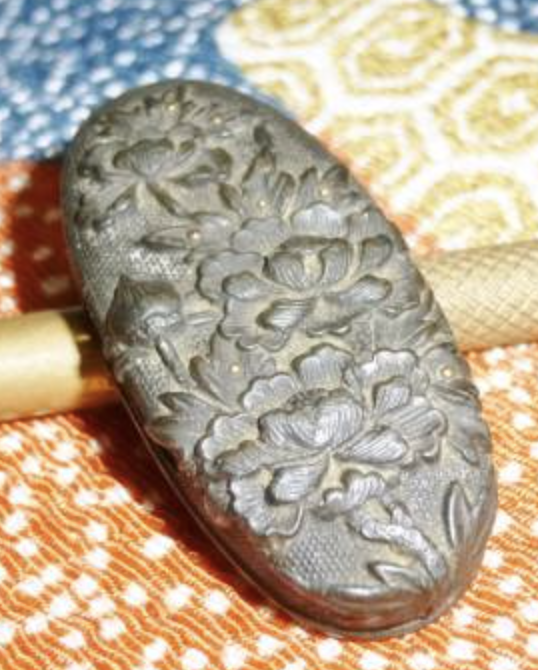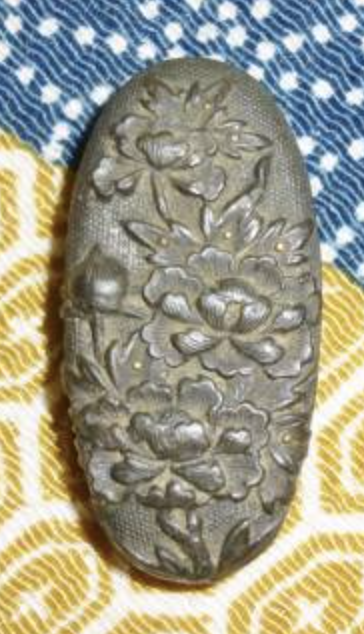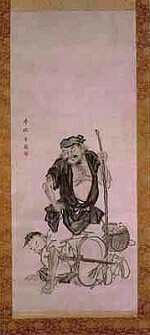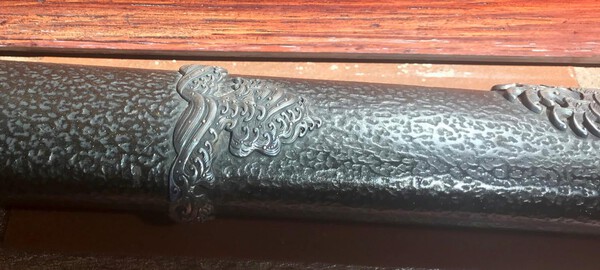-
Posts
858 -
Joined
-
Last visited
-
Days Won
7
Content Type
Profiles
Forums
Events
Store
Downloads
Gallery
Everything posted by Tanto54
-
Nice exhibit if you like the Tale of Genji, but unfortunately the exhibit has displaced all the nihonto related items (which have been relegated to storage in the basement along with the other 95% of their nihonto and tosogu collection that is never displayed). There is a Koto on display with fittings made by Goto Teijo. I'll post pictures in the tosogu section for those who are interested.
-
Dear Tom, It looks like the mekugi (bamboo peg) had been sheared off on each side and there is probably a small bit still in the nakago ana (tang hole) that has the tsuka (handle) jammed in place. You should work very slowly and carefully. It also appears that the tsuka has slipped within the wrap (based on the look of where the binding meets the kashira. I think that you should start by gently moving the sword back into the tsuka (instead of out of it) so that you can realign the holes in the tsuka with the hole in the nakago (tang). Once they are realigned, you can push out the small piece of remaining bamboo peg. In other words, I think the tang hole is above the hole in the handle if you hold the sword with the tip point up. It may be counterintuitive to force the sword deeper into the handle when you are trying to get it off, but I think that's what you need to do in this case. You can move the sword deeper into the tsuka by holding the tsuka in one hand with the tip of the sword point up (vertical). Tap the bottom of the tsuka (kashira or pommel) with the palm of your other hand. Inertia will cause the heavy sword to slowly move deeper into the tsuka (handle). Start lightly but you may have to tap it pretty hard. Keep checking to see if the holes are realigning. If they do, then get the remaining mekugi (bamboo pin) out. If not, then you'll have to try the block of wood tapping against the tsuba method (mentioned above) to remove the handle (but if it does have a small amount of mekugi remaining, it may jam and tear up the tsuka).
-
Dear Yamabiru-san, I agree with the other comments above and will add the following. With the current view towards modern ivory carvings (and to a large extent even antique ivory carvings), these kinds of modern netsuke have lost considerable value (even if they are "Grandfathered in" under the law by being older than the threshold date required). Good, antique, collectible netsuke are a lot like great nihonto and can go for thousands of dollars (and even hundreds of thousands for rare pieces). However, the type of netsuke that you have shown are modern tourist pieces that used to sell in tourist shops and jewelry stores for around $300 - $800, but they are now readily available for about $100 on the internet (and are a lot more like the modern "Samurai Swords" that are sold in some knife shops in some countries). Unlike collectible, antique netsuke, the signatures on these do not matter, so no need to try to track down the artist for each piece. There are some modern netsuke carvers who are very collectible (e.g., Ford Hallam's brother Clive Hallam), but your friend's netsuke aren't by any of the good netsuke artists. To identify elephant ivory, you should look for Schreger Lines which appears as intersecting arches or "cross-hatchng" in the ivory (see picture below). These lines may only show up in certain places on the piece. Other "ivory" (e.g., walrus tusks, mammoth ivory, antler, etc.) may appear like elephant ivory but generally will not have Schreger Lines. There are lots of fake netsuke made of resin (some are even very old), so some collectors use the "hot needle test". I don't recommend that test, but if the netsuke is low quality and probably fake, then there is little harm... Use a lighter to heat up a needle to red hot and touch it on an inconspicuous part of the netsuke (e.g., inside the himotoshi or rope hole) - if it melts, it's plastic. Sorry to say it, but I think that your friend would be lucky to get $100-200 for each piece today.
-
Greg, What are you really after? Isn't this just your sales pitch? You try to get people to tell you what they want and then you try to find it to play the middleman and take a cut (commission). Nothing wrong with that as long as you are honest about your intent.
-
Dear Tom, Are you sure that your Sensei wasn't pulling your leg? I wish there was a Snopes for Nihonto - I'm sure that the "Lady and the 7 Tangs" would be on there... Without a chopsaw, the effort to cut off 7 nakago would be tremendous (and my wife is one of the few women that I know with a chopsaw).
-
I thought that Grev's call (a partially opened flower with spikes) was a possibility. I'm assuming that the silver inlay (most of which has fallen out) depicts water droplets or dew, so petals or leaves would be a good possibility. Logan, when you look at them in hand, do you think that all the small circles and holes are where inlay have fallen out? Lost inlay of water droplets or spray usually appears as a small round circle often with an even smaller square hole in the middle (where the stem of the inlay was hammered down into in order to secure it in place). Two or three of the inlay are still there and look to me like small silver domes probably depicting water droplets. If those are supposed to be water droplets, then plant petals or leaves seems like a good possibility for the main shapes (perhaps something similar to a fish bento or rice balls wrapped and tied in lotus leaves). I also sometimes see those kind of water droplets on some aquatic subjects like sea cucumbers, etc.
-
Dear Grev, I recommend that you put it in the translation section - I am sure that it is a character superimposed over the moon/sun. Pine with two cranes is the symbol of Kotobuki in Japan which means longevity or congratulations. The character is in "seal" form (like on a round seal), so it won't look exactly like the regular kanji. Incorporating the character Kotobuki into a design with a pine and two cranes is not very unusual in Japanese art. Therefore, having a character incorporated into this tsuba with a pine and two cranes is not "out of character" at all.
-
Hi Grev, I think that it is the character for Kotobuki (longevity) over the moon and that fits with the other elements (pine, etc.).
-
I've found the originals that Luca's forgeries were probably made from. See below (study them closely - they are turned differently, but they are exactly the same). I've described the process of vulcanized rubber mold copying and lost wax casting of modern copies here before (see lost wax entries below the sand casting entries). Interestingly, in this case the forger used a different signature on the back (easy to change in the wax state). Original: Luca's Copy: Original Back: Luca's Copy Back: The seller of the original is samurai77ki on Yahoo Japan. Brian already did the detective work in discovering the jeweler making and selling the forgeries, but he would have had these originals to make his rubber molds.
-
Dear Tom, Given the rather poor chiseling of the Bonji in question, I think another possibility is that it is a DIY "atobori" added long ago by an ardent Buddhist owner.... (and before you ask, yes, I've seen those kinds of additions before - more than twice - and no, I don't have any ready pictures of them...)
-
Dear Luca, Who was the seller on Yahoo Japan? There are a number of sellers there selling obvious fakes, but it would be nice to know who else to avoid. Anyone selling these would almost surely know they were fake...
-
Dear Tom, I think that Ray and Uwe got it (the correct Bonji character). As Ray said, Bonji are also seen on nakago and Bonji are simply written characters (not just for horimono).
-
Thank you everyone! Good DYI Guido - that's the approach I will take - thanks!
-
Do any of our members/dealers sell good Japanese choji oil in the US? I've looked through all the commercial links and can't find anyone in the US who has it listed....
-
I think that Ford is correct - this is definitely dajare (Japanese wordplay). You should look for Japanese puns, legends or proverbs that use shakushi (the wood spoon), daikon, etc. Keep in mind that the items on the back might not be chestnuts (they are usually not depicted this way in Japanese art). Finally, notice how the "bowl" of the shakushi (spoon) has the exact same texture as a daikon, but usually the "bowl" of these spoons are smooth (so, perhaps, the "bowl" of the spoon is being "transformed" into a daikon, instead of the daikon being hidden behind it - see how the roots come out of the bottom and the leaves come out of the top?).
-
Hi Tom, I believe that this is Bonji (sanskrit) for Senju Kannon (the thousand armed Buddhist deity symbolizing compassion - avalokiteshvara). Senju Kannon is the protector of Japanese born in the year of the rat.
-
Very nice!
-

What menuki would you like to get your hands on?
Tanto54 replied to barnejp's topic in General Nihonto Related Discussion
Dear Greg, You are always asking these questions, so I think that it is only fair for you to tell us what you want... -
Outstanding! Thanks!
-
Hi Ken, Beautiful menuki. I've seen about a dozen of these long menuki over the past 40 years. The most memorable were sharks (a very rare subject) that were even longer than those dragons.
-

Menuki-Kashira recommendations based on existing Fuchi
Tanto54 replied to jdelayknee's topic in Nihonto
Dear Jerry, I did a quick search for orphan Botan (peony) kashira on Yahoo Japan and found this one. I think that it would be a reasonable match if the flowers were fire gilded. You could probably have one of our Board tosogu artists gild this for a very reasonable price. https://page.auctions.yahoo.co.jp/jp/auction/j406367449 -

Menuki-Kashira recommendations based on existing Fuchi
Tanto54 replied to jdelayknee's topic in Nihonto
Dear Jerry, In addition to the good suggestions mentioned by my colleagues above, if you want to stay as true to your Father's sword as possible, you might also consider having one of the tosogu artists on this Board make a new kashira that would match the original fuchi. For me, I'd either do that or search for an orphan kashira with a shishi (I've seen several over the past few years) or a peony. Some people enjoy the search and feel a great sense of accomplishment when they find something that works. -

Menuki-Kashira recommendations based on existing Fuchi
Tanto54 replied to jdelayknee's topic in Nihonto
Dear Jerry, Your Tsuba depicts the legend of Kanshin (Han Xin in Chinese). Kanshin was a famous general during the Han Dynasty. To many Japanese, he is the model of humility and restraint because of an incident from his youth. Even though he was very skilled with a sword, when a ruffian called him a coward in the marketplace, Kanshin restrained himself. He even endured the humiliation of crawling between the bully's legs (a common form of hazing or bullying in China/Japan at the time) when he could have easily drawn his sword and killed the man instead. He is often depicted on kodogu and other Japanese art in the process of crawling towards the bully's open legs (see picture below). Your Fuchi appears to be a shishi (lion dog). They come best in pairs or with a Botan (Peony). The combination of lion dogs (shishi) and peonies (Botan) is a popular motif in Japanese art (see my Avatar). You can search Shishi Mai (lion dog dance) or Shishi Botan for more information. The combination symbolizes bravery and elegance and represents the spirit of the Samurai. Legend says that the lion dogs loved to eat these flowers so they are often seen together. In addition, the peony is considered the "Queen of Flowers" and the shishi is considered the "King of Beasts" so the combination is also a good yin/yang. There is also the legend of Shakkyo and Monju Bosatsu which has a shishi that prances around a peony (that's why you often see the shishi dancing around a peony on larger surfaces like tsuba). Therefore, I believe the theme of your sword is restrained courage, and I would follow that theme in choosing your other parts. For example, I'd get a Botan (Peony) (with or without a Shishi) for the Kashira, and I'd do the same for the menuki. -
Hey, I’m back from my trip, and I agree with Ian about the motif. The story depicted is Susano-o defeating the eight headed dragon/serpent Yamata-no-Orochi and relates how the most important Japanese Sword (Kusanagi-no-tsurugi - one of the three great Imperial Treasures of Japan) was discovered. Susano-o (also known as Kumano Ketsumiko no Kami) was a demigod who had been cast out and was traveling in Izumo, Japan. He came upon an crying elderly couple with a beautiful daughter. They explained that every year for the previous eight years they had been forced to sacrifice one of their daughters to the huge eight headed dragon/serpent monster (Yamata-no-Orochi), and now they were going to have to sacrifice their final daughter Kushinada-hime to the monster. Susano-o thought she was hot so he struck a deal with her parents that if he would slay the monster, then they would let him marry Kushinada-hime. Susano-o started by turning Kushinada-hima into a comb and putting her in his hair to protect her and keep her out of the way (nice trick - wish I could get my wife out of my hair that easily….) Then he told the old couple to brew some really strong sake because, as everyone knows, dragon/serpent monsters love sake. Once it was done, he put it in eight huge jars on pedestals in the water. Then they all hid and waited. As soon as Yamata-no-Orochi (the monster) appeared each of his eight heads started guzzling sake. Soon the monster was drunk and our hero, Susano-o crept out and cut off each of the monster’s heads and tails (he also had eight tails). While cutting off one of the monster’s tails, Susano-o’s sword broke on something very hard inside the dragon/serpent’s tail. When he opened up the tail, Susano-o found the Kusanagi-no-tsurugi (The Great Sword Kusanagi). He gave the sword to his sister Amaterasu (because that’s what heroes do when they find the most bad-assed sword ever - right???) and it eventually became one of the three great Imperial Treasures of Japan (along with the mirror and the jewel - but you already knew that didn’t you?) This is one of the reasons that Goto and other dragons have a ken (sword) on their tail (you often see this on menuki). Susano-o settled in Izumo with his new hot wife Kushinada-hima. My wife and I visited there last year and saw some of the places and temples mentioned in this legend. It was a fantastic trip. Still waiting on an invitation to see Kusanagi-no-tsurugi…. By the way, Susano-o (our hero) was born from the snot when the great god Izanagi blew his nose (I’ve been looking for that on a tsuba for more than 40 years….)
-
Here's one that I really like (the area where it was worn against the hip has been smoothed from years of service - not included in the picture...)


